As we have traveled around the world, we have moved on to countless new cities and countries. While there have been many incredible experiences, there are some days we will never forget.
Driving our own motorbikes from Hue to Hoi An by traversing the Hai Van Pass was an incredibly memorable day for us as we traveled through Vietnam.
Spectacular panoramic views, death defying roads and constantly evolving climates await you on the Hai Van Pass as you proceed along the surprisingly short otherwise known as ‘Ocean Cloud Pass.’
Ultimately, we decided to pay for an individual guide so we could completely relax without worrying about directions and where to stop. We wanted to enjoy the day with no navigational or scamming concerns.
The route can be driven without a guide if you are on a tight budget or you already know you way. But our detailed motorbike travel guide from Hue to Hoi An will show you exactly what to expect for your trip.
Let’s drive the Hai Van Pass!
Brief History Of The Hai Van Pass, Vietnam
The Hai Van Pass certainly delivers aesthetics. But historically, this was an important defensive barrier for any army who attempted to march North or South of the pass.
Interestingly, the pass marks the boundary between Northern and Southern climates in Vietnam, even shielding Da Nang from harsh Northern winds.
The French built bunkers at the summit of the pass to overlook the South China Sea to the East. A ‘gate’ was built earlier by the Nguyen dynasty in 1826 to protect Imperial City Hue.
This picturesque gate and bunker complex is popular for wedding photographs today.
Some of the bunkers were later used by the Americans and South Vietnamese during the war and Vietcong forces would ambush the bunkers regularly.
Once the BBC aired its Vietnam Top Gear Special and Clarkson et al had waxed lyrical about the beauty of the Hai Van Pass, all of a sudden this usually quiet locals only coastal road blew up with tourists.
Isn’t it incredible how one single episode of a British television show can have such a meteoric impact on so many people’s lives?
Need help traveling from Da Nang and Hoi An? Don’t miss our popular Da Nang to Hoi An transport guide.

Hue To Hoi An Route Interactive Map
Total journey length from Hue to Hoi An including the scenic Hai Van Pass road is roughly 160km, once off piste adventures along the way are considered.
The map indicates a 3 hour drive. Even with no stops at all, you would struggle to drive the distance in that timeframe. Our day lasted over 8 hours door to door.
Allow yourself a full day for this unforgettable ride to make sure you see everything along the way.
There are 3 ways to cross the Hai Van Pass:
- One is to take the scenic train around the mountain, tightly hugging the coastline and entering a number of tunnels.
- The second is to drive over the scenic pass, reaching a summit of 496m (1,627 feet) of elevation. The best views of all options.
- And the third is to drive directly straight underneath the pass, through the longest tunnel in South East Asia at 3.9 miles. It was built in 2005 to alleviate heavy road traffic and accidents on the snaking summit roads.


Why Travel From Hue To Hoi An By Motorbike?
The sense of satisfaction washing over us as we handed our motorbikes in to the hiring office in Hoi An was an amazing feeling.
We had just independently driven motorbikes for over 8 hours from one city to another, over a small mountain pass in Vietnam.
Scary? A little. Dangerous? Kind of. Exhikaterating? Hell yes!
Never mind the winding snaking roads on the pass itself, there are several highways with lorries (trucks) and buses overtaking you at high speed. It constantly sounds like a fleet of jumbo jets are tight on your 6.
But you have achieved this yourself. You handled the bike. You conquered your fear.
In truth, this route can be enjoyed from the back seat of a private car or a minibus. We even saw a few open top jeeps but in our opinion, it just wouldn’t be the same.
Maneuvering acutely around hairpin bends in foreign territory releases bursts of adrenaline. Having the freedom to pull over every time you see something interesting means you don’t miss a thing.
We also quickly learned motorbikes can go where cars or buses can’t, down narrow dirt roads and through the beautiful rural countryside.

Should You Travel The Hai Van Pass Individually Or Pay For A Guide?
Choosing to travel from Hue to Hoi An by motorbike is the first step. We would like to congratulate you on your excellent decision.
Now, you need to decide whether it’s a journey you want to make independently or with a guide.
Personally, we recommend booking a guide for a few reasons:
- Having a guide eliminates the need for you to navigate using your SIM or offline map you saved when you had WiFi. Trust us, it’s a long journey.
- A guide knows the quieter roads and deals with all locals at entrances as well as prevents potential scams.
- Another benefit to a guide is they will clear any traffic in your path and warn others you are coming when necessary.
- Last and certainly not least, a guide knows all the best places to stop for scenic views, attractions and food.
Having a guide made our ride completely stress free. Take a guess how much it cost us to hire a guide for this trip from Hue to Hoi An? We’ll tell you in the next section about hiring a motorbike.
You can of course drive this route independently and many people will without any issues. But we would suggest that only experienced and confident motorbike riders go it alone. Prior experience driving in Vietnam is a must.
If you don’t feel confident enough to drive your own bike but definitely want to experience this route by bike, you can even ride on the back of a guides bike instead.
Traffic in Vietnam is different beast! We saw at least 10 other groups riding with guides on our journey.

How To Book A Hai Van Pass Motorbike Tour
As tourism continues to grow in Vietnam, special trips like the Hai Van Pass become increasingly more popular. So with many options available, we wanted to be sure we found the right tour for our needs.
When we asked our hotel owner in Hue about the best companies to use when booking a motorbike tour of the Hai Van Pass, she told us that MotorVina was the best company to book with.
Since we had already built up a good rapport with her, we trusted her opinion, but of course being analytical scientists by nature we still checked reviews online.
But once we saw the incredibly high ratings and positive reviews for MotorVina, we knew we were in good hands.
MotorVina has offices in Hue, Da Nang and Hoi An, which means you can start and end wherever suits your schedule.
But what about your backpacks? This is the beauty of booking with Motorvina! They will transport all of your luggage to your final destination.
You can choose to simply hire a motorbike with a guide or hire a guide to ride pillion (on the back). We hired a guide plus two motorbikes so we could each drive the route on our own motorbike.
Our total cost was about US$ 80 per person for both of us to drive our own bikes over the Hai Van Pass with an amazing guide.
Our awesome guide was called Phu but went by rhyming alias ‘Dr. Who’ – another BBC show. When you book your Hai Van Pass tour, book it through Motorvina using the link below!
>> Book a Hai Van Pass tour with MotorVina: Get Your Guide | Viator

Hai Van Pass Packing Essentials
Below is a list of things you need to consider taking with you. Remember you will be exposed on a motorbike for the full 8 hours between Hue and Hoi An (or vice versa).
The Hai Van Pass is only a small section of the motorbike tour.
- Reusable Water Bottle – This sounds obvious but you will need as much water as you can fit into your seat. You will stop for lunch and can refill along the way, but always be sure to have some on hand.
- Reef Safe Sunscreen – Do not make that mistake! You will have the worst sunburnt arms, legs and face if you do not take sunscreen seriously.
- Waterproof Layer – Conversely, if the sun is not out, remember a warmer and waterproof layer. Even if the sun is out, temperatures and weather can change in minutes on the Hai Van Pass since it has its own mini microclimate.
- Swimwear – If you plan to take a dip in either the sea at Lang Co Beach or at Elephant Springs, you’ll need a change of clothes or just wear it underneath your motorbiking gear.
- Microfiber Towel – A towel will certainly come in handy if you decided to take a dip along the way or need to wipe the sweat from your brow during the day.

Best Time To Drive The Hai Van Pass
Vietnam is notoriously difficult to plan an itinerary due to the ever changing weather system. Always expect a variation of hot, humid, muggy, stifling and raining situations.
Additionally, when you’re in the North during Winter it might even get a little chilly.
The Hai Van Pass is even more unpredictable than usual for Vietnam. It’s named the ‘Ocean Cloud Pass’ after all!
The name alludes to the micro climate where it can be a beautiful day and all of a sudden you find yourself in a dense cloud of mist and rain at the summit.
Weather conditions are exceptionally changeable and it will boil down to luck on the day.
That being said, if you want to give yourself the best chance of a dry day, February to April is the driest season.
Visiting September to December statistically speaking will mean highest risk of rain, with October by far the wettest month.
Again, luck plays a huge part because we drove the Hai Van Pass in October and never saw a single drop of rain.
Our Hai Van Pass Motorbike Tour Experience From Hue To Hoi An
Now that we’ve covered all the preparation, let’s get down to what you can expect on your Hue to Hoi An motorbike tour across the ‘Top Gear’ Hai Van Pass.
In the next sections of our guide, we will show you the best things to do along the Hai Van Pass as well as some of the popular stops you shouldn’t miss.

1. Hotel Pick Up In Hue
The fabulous day began at 9:00am when we had our backpacks picked up to be driven to Hoi An.
Our automatic motorbikes were dropped off with Dr. Phu at our hotel in Hue. Kristen had a pink bike and Mark a white bike. We did the usual safety checks before hopping on.
We always recommend taking photographs of the bike exterior before you begin your ride. As always, make sure your helmet is also very secure.
Admittedly, we were both a little nervous (just look at Kristen’s face).
We had driven a little around Ninh Binh and Phong Nha on motorbike but nothing like an 8 hour slog over 160km and on serious highways.
However, Phu was amazing from the word go, he made us feel at ease and relaxed immediately.

2. Gassing Up In Hue
Getting out of Hue was interesting.
We made a beeline for the quickest way to reach the rural countryside South East of the city. Inevitably, there were a few near misses.
Well, they felt like near misses to us, but they were standard operating procedures to the locals. But in a surprisingly short amount of time we got the hang of traffic patterns.
It’s actually organized chaos that somehow works.
The worst thing you can do is dilly dally about. You need to be confident and once you begin a maneuver, make sure you complete it.
Drivers will yield once you are in motion, but if you are stopped, anything pretty much goes.
Sure, drive defensively, but that does not mean stop at a 4 way junction in the middle of the road. You’ll never get out.
It was great having Phu show us how to properly navigate the roads. We felt safe with him and it was worth the money alone just for the extra layer of safety.

Before we could cut off into the countryside, we needed to fill up the tanks. Phu led us into a real gas station and handled the fueling up while we shared a laugh of relief at each other for getting through the traffic in Hue, as our hearts were beating much quicker.
We say ‘real’ gas station because you will pass several people buying gas on the side of the road. You never know what is being sold in those “gas bottles” so just fill up at the actual gas stations.
Save yourself that drama, trust us.
3. The Countryside And Quaint Rural Fishing Villages
Full of fuel and newly found confidence, we followed Phu down some gorgeous narrow dirt roads cutting through waterlogged rice paddies.
Swerving left and right alongside fishing lakes and through rural villages, we began to relax as we were really getting the hang of this.
Now, in place of motorbikes as potential hazards, we now had to look out for loose chickens, children and rogue goats.
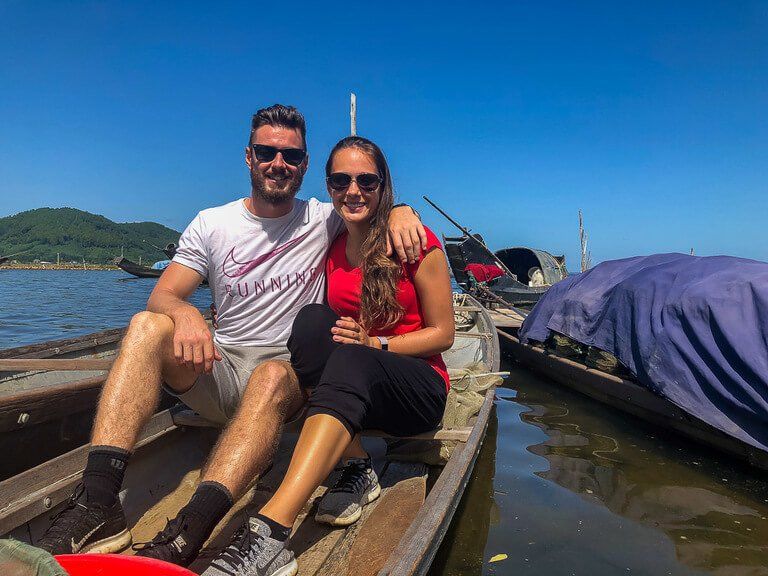
We stopped to admire some large straw structures with chicken coops inside. We also met a woman catching snails and she showed us her lucky technique.
As we rode on, we were blinded by intense reflecting sunlight surrounded by a rainbow of colors. What could this be?! It transpired that a rich local family had built an ornate family temple with colored glass.
The building was absolutely magnificent! Coincidentally, the owners now live in New York.
From experience, we can say Hue’s surrounding countryside is peaceful and extremely easy to drive around. You never know what or who you will run into.
4. Stopping At Elephant Spring
We stopped at a restaurant for a refreshing ice cold drink after a fairly long stretch of straight highway. We had been cruising at a pretty good speed to cover some ground so we were happy for the break.
Thunderous trucks howled by less than a meter from our parked motorbikes on the roadside in the makeshift parking lot.
Phew, it was sweltering and we were struggling to get our sunscreen to soak in before sweating it off instantly.
After our refreshing drink, we only drove a short while until we pulled off the main road and followed a poorly maintained dirt path to Elephant Springs.
There was a barrier crossing the track and an entrance fee required. We gave Phu 2,000 VND each to pay for our motorbike parking and he handled the rest.


Elephant spring is nothing to shout home about but you will be ecstatic when you get to jump in the plunge pool area to cool off.
Other tourists were submerged in the water trying to escape the inhospitable baking sun.
Before jumping in, we walked up some wooden boardwalks and over some boulders to check the area out.
Phu took some photos of us on elephant rock, which obviously has been man made using wrought iron bars to hold the rock in place.
But after a few photos, we both enjoyed jumping in to cool off from the heat and humidity. If its busy when you visit Elephant Springs, there are plenty of spots to explore upstream if the natural pool is full at the bottom.


5. How To Remove A Leech From Your Leg
After swimming against the strong river current and walking around a bit, there’s not much else to do here. Except of course if you discover you have a leech on your leg!
Mark had to call in the cavalry, aka the guy lighting his cigarette in one hand and lighting the leech on Mark’s leg in the other.
There were no screams, we promise. Phu of course oversaw the entire de-leaching process.
The moral of the story here is to check for leeches if you decide to take a dip in Elephant Springs.

6. Lang Co Lagoon
Not far from Elephant Springs is Lang Co beach, which is one of the prettiest areas of the day. We were hungry but before stopping for lunch we drove along the narrow spit of land separating the sea from a small lagoon.
Around a dozen lagoon or beachside restaurants made of wood sitting on stilts provided an extremely serene atmosphere. There were some super photogenic spots within the lagoon that were completely unexpected.
Be sure to look out for wooden rafts, leafless tree branches rising out of the still water and lifeless wooden boats if you want some great photos.
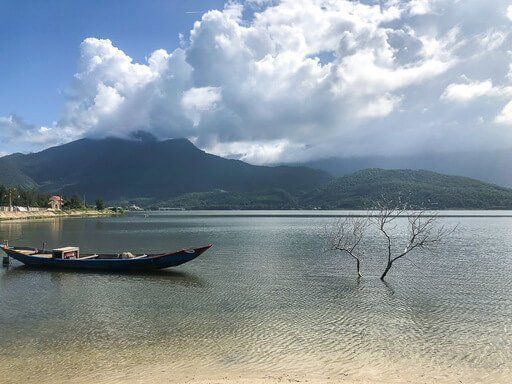

7. Lunch Stop At Lang Co Beach
We pulled into one of the chilled out looking wooden restaurants and picked a table under cover to escape the sun for some respite. The menu looked great.
We ordered rice and vegetables then sat enjoying the sound of waves crashing on the beach. The waves provided a nice change from the loud hum of the motorbike engines and traffic.

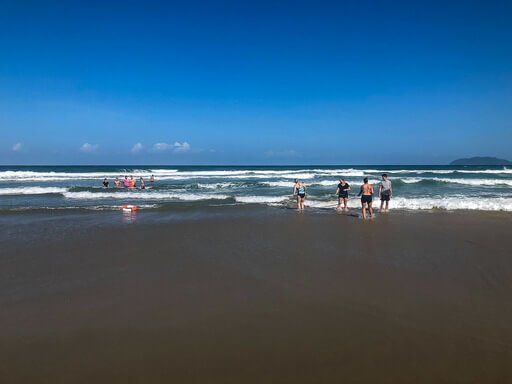
But the calmness was broken up by a faraway sound, like a shriek. As we looked at other tourists on tables nearby, it seemed everyone had a ‘did you just hear something’ look on their faces?
Then we heard the sound again, but louder this time. It was someone shouting ‘HELP’ from the sea.
A Dangerous Rip Current
Instantly all of us in the restaurant jumped up and ran to the beach. It’s interesting to see how we all react differently in stressful situations.
A guy on a table nearby did a David Hasselhoff, sprinted for the sea without thinking and was on his merry way out to sea.
However, what he didn’t realize was that he was swimming into the same strong rip current the other guy was already stuck in.
Unfortunately, Mark had experience from when he got stuck in a rip current in Thailand a few years prior to this incident.
He knew the best thing you can do in this situation was to swim perpendicular to the rip current which meant parallel to the beach because you will eventually swim out of it.
So we quickly analyzed the beach, wave direction and estimated the edge of the current.
We instructed other tourists and restaurant workers (who were worrying a lot now) to gesture frantically to the left. As both men were now stuck in the rip current and the only chance they had was to swim out of it.

Eventually, the first guy made his way left and finally back to the beach. He was exhausted and really shaken up. Hasselhoff followed a few minutes later in better shape but still extremely tired.
The initial guy thanked everyone and said he genuinely thought he was going to die.
Our blood pressure dropped dramatically as both men made it out of the water safely. Everyone involved was relieved the situation had not turned out much worse.
Travel Tip: If you plan to swim at any of the beaches along your Hai Van Pass motorbike tour, be very careful because rip currents are common along Vietnam’s central coast.
8. A Bit Shaken Up
After the commotion, we ate and took a short walk along the beach. Getting back on our motorbikes after what we had just witnessed felt insignificant.
We made sure both men were okay again once they had some time to compose themselves.

To get the full effect of the beach, we took off our shoes to feel the sand scratch lightly on our feet. We also admired some large wooden boats shaped like bananas that were bigger than us.
But it was time to get back on the road. We could see the Hai Van Pass towering ahead of us with thick clouds at its summit, but we couldn’t wait to get up there and shake this off.
9. The Official Hai Van Pass Begins
We hit the road having thankfully avoided witnessing someone drown.
And what a stunning road it was!
The route begins by crossing gorgeous Cau Lang Co Bridge over the lagoon.

We didn’t fully appreciate the beauty of the view over the bridge until we were further around the headland looking back at the scene.
If you’re exceptionally lucky, you might see a train heading for Hanoi or Ho Chi Minh City as you cross the bridge. We were not so lucky.
Instantly the roads begin to acutely curve out of sight. We were performing 270 degree turns to follow the correct trajectory. Now this was getting fun…
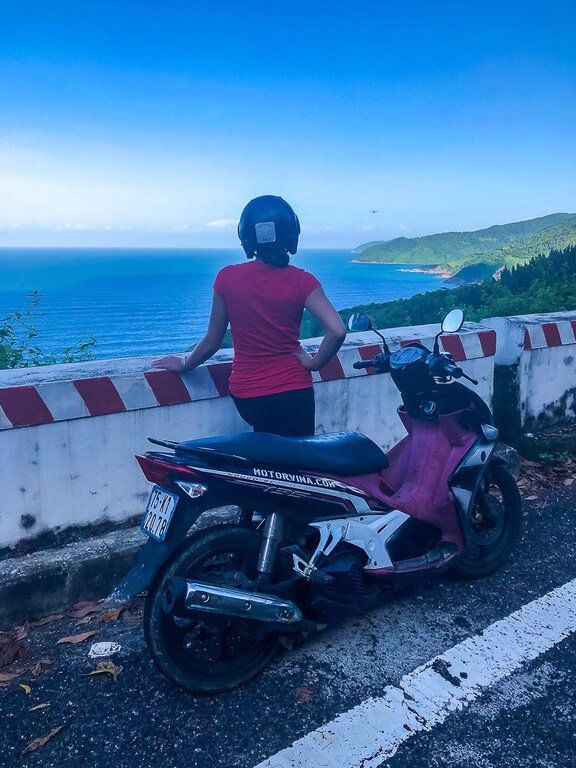
There are several hazards and obstacles to keep in mind. These hurdles come in the form of other people either driving trucks or huge buses overtaking on blind corners.
There is also the occasional hot headed tourist trying to become the next Valentino Rossi.
All we could do is drive defensively and safely without going too slow that we caused an accident. There were temptations to gun it but there are other people to consider.
If the road was guaranteed to be clear, it would have been a whole different story.
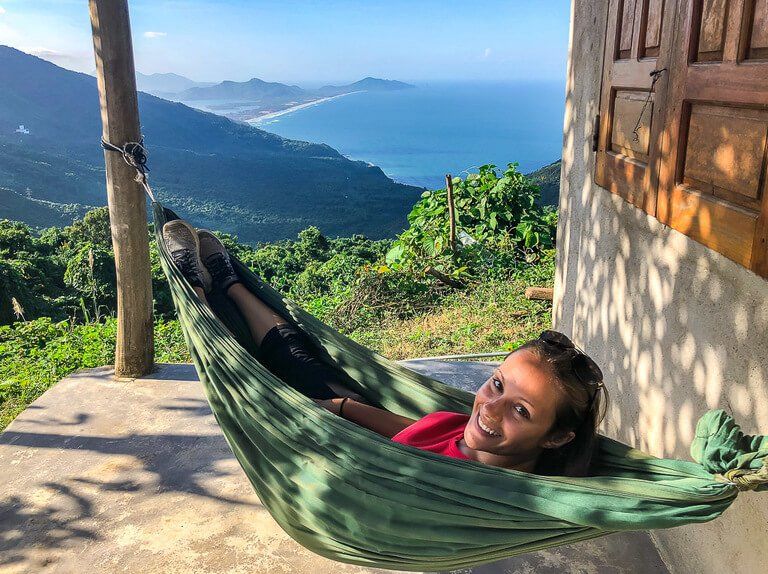
Have you ever seen aerial photos of hairpin roads snaking up a mountain side? This is exactly what you are gliding around on the Hai Van Pass and it’s amazing!
Be sure not to get carried away in the moment, stop from time to time to take it all in.
One of the stops Phu had us pull over at had some hammocks where we could lounge around for a few minutes. This was definitely the best way to appreciate the spectacular view over Lang Co Bay.
10. Hai Van Pass Summit
We knew we had reached the summit as we turned the last corner.
There were so many buses, cars, jeeps and motorbikes parked all over the road. The Hai Van Pass is quite touristy, but we only realized this once we were at the top.
Luckily, during our journey we had avoided most of the crowds.


At the summit, there are a few small places to grab some food, coffee or a beer but don’t expect much.
A huge rusting old road sign is the first landmark we noticed, but further up a dirt path right off the road you can visit the old French bunker and Nguyen gate.
From this spot, there are more wonderful views of Lang Co beach in the distance.


To be honest, we didn’t spend much time at the summit. It was overcrowded and apart from the historical significance of the bunker which we quickly read about, there wasn’t much else to keep us up there.
Phu told us the better views of Da Nang were on the way down the other side. His tip was all we needed to get a move on.
11. The Descent Into Da Nang
Phu was absolutely correct! The panorama over Da Nang city on the descent closely rivaled the scenes of Lang Co beach on the other side of the pass.
We couldn’t decide which was more attractive, so we called it evens.

Descending the Hai Van Pass is easier and more relaxing than ascending because gravity together with wheels do all the work for you. But don’t let your gaze wander too much because you still have to be alert.
We stopped a good 4 or 5 times to enjoy the cityscape view of Da Nang, its bay and the headland. It was getting late in the afternoon and the sun was heading West behind the summit so our descent was shrouded in shadow.
Bad for photos but good for shielding from the intense sun for a welcome change of temperature.

Da Nang is Vietnam’s third largest city. Unfortunately, there is a relative amount of traffic to go along with that title.
We crossed the awesome and unique Cau Rong bridge, with a gigantic dragon slaloming through its center. We all continued to Da Nang’s beachside road.
This road was very popular and stacked full of traffic lights at every block, which meant it took a long time to get to the marble mountains.
12. Final Stretch To Hoi An
It was getting late in the day by the time we had reached the marble mountains.
We didn’t have enough time to hike any of the small trails which was a shame, but we still asked Phu to show us some of the marble display rooms where locals create huge sculptures.

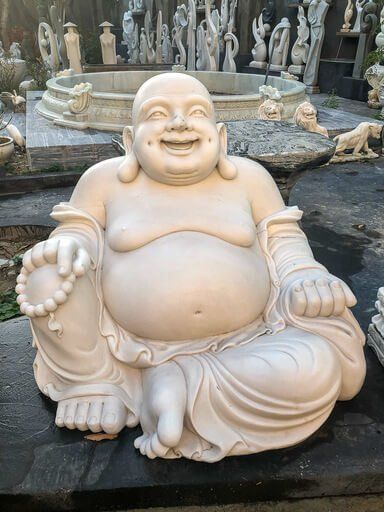
The showroom he took us to had hundreds of marble statues of all shapes and sizes. He told us tourists often have them shipped to their home countries.
Now we know where that statue came from in Mr. Smith’s garden!!
13. Hai Van Pass Hue To Hoi An Conquered
The final stretch of road towards Hoi An was busy and natural light was failing as night approached.
Fortunately, Phu knew a few shortcuts on very narrow roads running between rice paddies in the countryside outside Hoi An town.
He took us for a very brief stop off at a friends curated and lush green garden. Before we knew it, we had arrived in Hoi An at the MotorVina office.

We simply signed our document to say we’d arrived and picked up our deposit once we ended at the office.
Phu had Kristen sit on his back seat and another guy from the office put Mark on the back of his as they whisked us off to our hotel in Hoi An.
We had mixed feelings as we handed our bikes in, picked our backpacks up and said goodbye to Phu. What a day.
We were exhausted, but didn’t want the day to end. As the adrenaline wore off, we also quickly noticed our stiff legs and numb butts!

We had successfully conquered the Hai Van Pass by driving our own motorbikes all the way from Hue to Hoi An and we had survived to tell the story.
Now it was time for a celebratory beer!
Hai Van Pass FAQ’s
Let’s take a quick look at some of the most frequently asked questions about the Hai Van Pass in Vietnam.
If you drove the Hai Van Pass without stopping, it would take about 3 to 4 hours. But most people make several stops along the way and take about 5 to 8 hours to complete the entire trip from Hue to Hoi An.
Yes, the Hai Van Pass is worth it because you will experience many scenic vistas and have the chance to drive a motorbike over a mountain pass with gorgeous windy roads. The Hai Van Pass is one of the best things you can do in Vietnam and it’s a perfect activity for adventure lovers.
The Hai Van Pass is 496m or 1,627 feet in elevation.
Our Popular Guides For Vietnam
- Vietnam – Best things to do and places to visit in Vietnam
- Hanoi Itinerary – Things to do in Hanoi with 2 day itinerary
- Sapa Itinerary – Best things to do in Sapa, Vietnam
- Northern Transport – How to get From Hanoi to Halong Bay
- 3 Week Itinerary – 3 week route for Northern and Central Vietnam
- 10 Day Itinerary – 3 x 10 Day Northern and Central Vietnam routes
- Ninh Binh Itinerary – Ninh Binh Itinerary with best things to do
- Phong Nha Itinerary – Best things to do in Phong Nha
- Hoi An – Amazing things to do in Hoi An ,Vietnam
More From Vietnam
- Tips – Important things to know about Vietnam
- Sapa – How to find a guided trekking tour in Sapa
- Hang Mua Peak – Guide to climbing Mua Cave Viewpoint
- Trang An – Everything you should know about a Trang An boat tour
- Halong Bay – How to book the perfect Halong Bay Cruise
- Southern Transport – How to get from Da Nang to Hoi An
- Dark Cave – Is dark cave worth visiting in Phong Nha?
- Hue – How to find the abandoned waterpark in Hue
Want more Vietnam content? Head over to our Vietnam Travel Guides to see example itineraries, tips about Vietnam and popular city guides.
We hope our Hai Van Pass travel guide helps you plan your motorbike tour!
Please let us know if you have any questions about the Hai Van Pass or Vietnam in the comments below.
Happy Travels,
Mark and Kristen
Enjoy This Hai Van Pass Guide? Pin It For Later!


Note: This article contains affiliate links. When you make a purchase using one of these affiliate links, we may earn a small commission at no extra cost to you.
All Rights Reserved © Where Are Those Morgans, LLC. Republishing this article and/or any of its contents (text, photography, maps, graphics, etc.) in whole or in part is strictly prohibited.
Mark and Kristen Morgan are travel, hiking and photography experts. Over the last 6 years traveling full time, they have explored more than 40 countries and 30 US states.
Where Are Those Morgans has been featured in USA Today, Gestalten, Get Your Guide, CityPASS and Condé Nast Traveler along with various other publications. Read more about us.



Great blog! Do you think driving this route is possible with no prior motorbike experience?
Hi Clodagh, yes it is possible with no prior motorbike experience. Kristen had no motorbike experience prior to driving this route. However, we would definitely recommend you hire a guide in that case so you can focus on your driving instead of worrying about finding the best spots along the Hai Van Pass. Enjoy the drive!